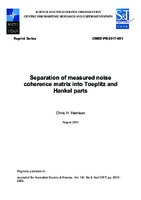| dc.contributor.author | Harrison, Chris H. | |
| dc.date.accessioned | 2018-10-11T14:09:57Z | |
| dc.date.available | 2018-10-11T14:09:57Z | |
| dc.date.issued | 2017/08 | |
| dc.identifier | 101476 | |
| dc.identifier.govdoc | CMRE-PR-2017-001 | |
| dc.identifier.uri | http://hdl.handle.net/20.500.12489/707 | |
| dc.description.abstract | The cross-spectral density of ocean ambient noise is usually estimated from the product of the complex hydrophone signals, each of which already corresponds to the summed responses of sources from all angles. The true coherence is the integral over all angles of the angle-dependent product. The influence of this distinction on necessary time integration in geoacoustic inversion and passive fathometry is explored, and a meaningful separation of the cross-spectral density matrix into Toeplitz and Hankel parts is proposed. Various processing techniques are applied to synthesized data and some experimental vertical array data in a passive fathometry context. Passive fathometry is only sensitive to the Hankel part of the matrix. | |
| dc.format | 9 p. : ill. ; digital, PDF file | |
| dc.language | English | |
| dc.publisher | CMRE | |
| dc.source | In: Journal of the Acoustical Society of America, Vol. 141, No.4, April 2017, pp. 2812-2820. | |
| dc.subject | Underwater acoustics | |
| dc.subject | Ambient noise | |
| dc.subject | Geoacoustic inversion | |
| dc.subject | Passive fathometry | |
| dc.subject | Toeplitz matrices | |
| dc.subject | Hankel matrices | |
| dc.title | Separation of measured noise coherence matrix into Toeplitz and Hankel parts | |
| dc.type | Reprint (PR) | |
| dc.type | Papers and Articles | |
